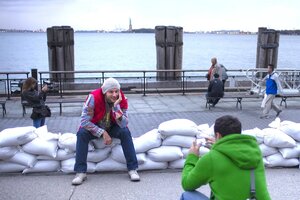What lessons from hurricane Sandy?
The best response to natural events like hurricane Sandy lies in a community preparing its political, civic, and even cultural attitudes. Each disaster, such as Katrina, teaches new lessons. What can America's mid-Atlantic region learn from Sandy?

The Statue of Liberty is seen in the background as tourists pose for pictures on top of sand bags protecting Battery Park in New York from the effects of hurricane Sandy.
Reuters
When a massive natural event like hurricane Sandy strikes, most people make material preparations for the worst – a necessary batten-down-the-hatches response. Plywood and other supplies fly out of the local Home Depots. Coastline families evacuate.
But behind that wise adaptation lies a more important response, as climate-change journalist Mark Hertsgaard points out in a recent book, “Hot: Living Through the Next Fifty Years on Earth.”
He writes that “social context matters more than technological prowess.” That context includes a “mix of public attitudes, cultural habits, political tendencies, economic interests and civic procedures.”
That is, it is the bonds that hold a community together that matter. Qualities such as resiliency, foresightedness, affection. Such attributes make a big difference in dealing with potential disaster.
Mr. Hertsgaard traveled the world to find good examples of climate-change adaptation. He discovered that wealth or material resources may not count as much as ingenuity and social cohesion.
In the dry Sahel of northern Africa, for example, he found some of the world’s poorest and most illiterate farmers have bonded together to grow trees near their crops. That effort helped to rehabilitate “degraded savanna that was on the verge of becoming a desert.” He called it a “green miracle.”
Their response to drought and desertification can be compared to the way that the wealthy Dutch have worked over the centuries to hold back sea flooding through elaborate dikes and waterways.
His advice matches up with the way that the United States has learned to adapt to natural events since hurricane Katrina in 2005. That storm showed just how political problems – as seen in the government hallways of New Orleans, Louisiana state, and Washington, D.C. – can lead to inadequate preparation for disaster. After Katrina, every top elected leader in the US is now out in front of a big storm, preparing communities.
After hurricane Irene hit Vermont with heavy flooding in 2011, that state pulled together to adjust its rules for human habitation along rivers and for channeling waterways. In Australia, which suffered a decade-long drought, officials have developed new ways of farming and water management.
After the 2011 tsunami devastated northeast Japan, local residents were largely cut off from the central government, forcing them to fall back on the ancient Japanese virtue of koh, or a shared spiritual purpose reflected in mutual help. They developed local markets and a strong volunteer response.
As America’s mid-Atlantic seaboard recovers from hurricane Sandy, even more lessons will be learned in adaptation and preparation. Communities will rediscover the bonds that matter and the civic actions that will protect all people in the future.
Storms may be physical beasts, but human societies can match them with the resiliency of the highest qualities.

